Family Name: Oxalidaceae R. Brown
Synonym(s): Averrhoaceae Hutch.
Common Name(s): wood-sorrel family
*Number of genera/species: 5/570
List of genera records in GRIN-Global
Fruit a berryberry:
an indehiscent, fleshy fruit with one or a few to many seeds. The flesh may be homogenous throughout. Or, if the outer part is hard, firm, or leathery, referred to as an hesperidium. Septa are present in some, and the seeds may be arillate or with a fleshy testa.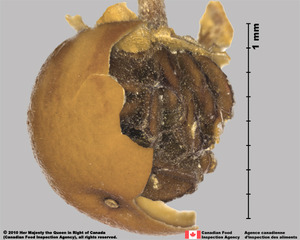 (Averrhoa, Sarcotheca) or a loculicidalloculicidal:
(Averrhoa, Sarcotheca) or a loculicidalloculicidal:
type of capsular dehiscence, opening longitudinally through the locules (compare septicidal)
 capsulecapsule:
capsulecapsule:
a dry, dehiscent fruit derived from a compound ovary (fleshy, Dapania), becoming schizocarpic in Biophytum, 2–30 mm long (capsulescapsule:
(fleshy, Dapania), becoming schizocarpic in Biophytum, 2–30 mm long (capsulescapsule:
a dry, dehiscent fruit derived from a compound ovary ) or 8–150 mm long (berriesberry:
) or 8–150 mm long (berriesberry:
an indehiscent, fleshy fruit with one or a few to many seeds. The flesh may be homogenous throughout. Or, if the outer part is hard, firm, or leathery, referred to as an hesperidium. Septa are present in some, and the seeds may be arillate or with a fleshy testa. ), globoseglobose:
), globoseglobose:
3D shape—more or less spherical to angularangular:
to angularangular:
2D shape—having sides that meet at acute or obtuse angles
, tereteterete:
approximately circular in cross section; width and thickness approximately equal
 or stellatestellate:
or stellatestellate:
star-shaped; with radiating branches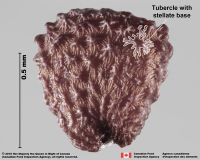 in transection, usually with one to 50 seeds (numerous, Averrhoa), calyxcalyx:
in transection, usually with one to 50 seeds (numerous, Averrhoa), calyxcalyx:
the outer whorl of the perianth; all the sepals of a flower and stylestyle:
and stylestyle:
in a flower, the narrow and elongated part of the pistil between the stigma and the ovary; sometimes persisting in fruit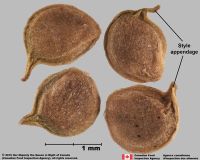 sometimes persistent (Oxalis). Pericarppericarp:
sometimes persistent (Oxalis). Pericarppericarp:
fruit wall or fruit coat
brown, reddish brown, green, yellow, red, or white, fleshy or membranousmembranous:
texture—extremely thin, pliable, and fairly tough
, and glabrousglabrous:
without hairs
or pubescentpubescent:
surface relief—bearing hairs
. Pericarppericarp:
fruit wall or fruit coat
usually 5-lobed, prominent to inconspicuous, often deeply so (Averrhoa spp.).
Seeds globoseglobose:
3D shape—more or less spherical to triangulartriangular:
to triangulartriangular:
2D shape—three relatively straight sides with distinct corners; more angular than teardrop-shaped , often compressedcompressed:
, often compressedcompressed:
flattened; in grasses, used to denote compression (not necessarily flattened) either laterally or dorsiventrally
in transection, 8–15 mm long. ArilsAril:
(broad sense) appendicular structure that wholly or partly envelops a seed and is produced from or a modification of the funicle, raphe, or outer integument; usually fleshy or pulpy, sometimes spongy or tufted-capillate, often brightly colored present in Dapania and some Averrhoa species. In Dapania, arilsaril:
present in Dapania and some Averrhoa species. In Dapania, arilsaril:
(broad sense) appendicular structure that wholly or partly envelops a seed and is produced from or a modification of the funicle, raphe, or outer integument; usually fleshy or pulpy, sometimes spongy or tufted-capillate, often brightly colored are bright, whitish yellow, fleshy, irregularly crenatecrenate:
are bright, whitish yellow, fleshy, irregularly crenatecrenate:
having a margin with low, rounded or scalloped projections , envelop the seeds, and aid in seed expulsion from the fruits. Seed black, purple, brown, yellow, or red, if ridgedridged:
, envelop the seeds, and aid in seed expulsion from the fruits. Seed black, purple, brown, yellow, or red, if ridgedridged:
surface relief—raised, thick ridges, sharp edged or rounded, usually in a series that may cover the entire surface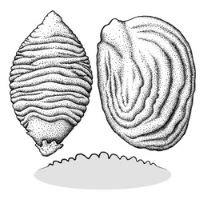 or with warts, then these may differ in color from the seed body, dulldull:
or with warts, then these may differ in color from the seed body, dulldull:
reflecting only a low proportion of incident light, with no apparent sheen , hard or crustaceouscrustaceous:
, hard or crustaceouscrustaceous:
texture—thin, dry, indurate, and brittle
, relief variable. In Oxalis, epidermis of seed coat is fleshy, smooth, and splits at maturity to eject seed. Seed coat mucilaginousmucilaginous:
resembling mucilage; moist and sticky
when wetted in Biophyllum and Oxalis.
Embryo well developed, partially to nearly filling seed cavity, axileaxile:
on or of the axis
and centric, foliatefoliate:
appearing leaf-like
, straight, with spatulatespatulate:
2D shape—like a spatula; rounded at the apex, with base long and tapered; (of embryo) embryo is straight and axile and centric with the cotyledons expanded to form the shape of a spatula or spoon; (of cotyledons) cotyledons expanded and wider than the stalk but not invested into the stalk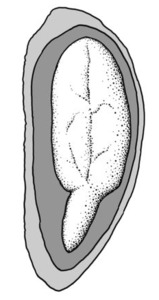 cotyledons. Embryos green in Oxalis.
cotyledons. Embryos green in Oxalis.
Endosperm copious, fleshy, smooth or ruminateruminate:
testa or seed coat folded into the endosperm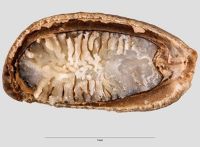 (Oxalis).
(Oxalis).
| Fruit | |
| Type | capsulecapsule: a dry, dehiscent fruit derived from a compound ovary  , berryberry: , berryberry:an indehiscent, fleshy fruit with one or a few to many seeds. The flesh may be homogenous throughout. Or, if the outer part is hard, firm, or leathery, referred to as an hesperidium. Septa are present in some, and the seeds may be arillate or with a fleshy testa.  |
| Size range | 2–150 mm long, capsulescapsule: a dry, dehiscent fruit derived from a compound ovary  less than 30 mm long less than 30 mm long |
| Shape(s) | globoseglobose: 3D shape—more or less spherical  , ellipsoidellipsoid: , ellipsoidellipsoid:3D shape—elliptic , fusiformfusiform: spindle-shaped; broadest at the middle and tapering at both ends 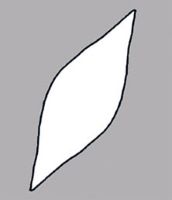 , ovoidovoid: , ovoidovoid:3D shape—ovate  , cylindricalcylindrical: , cylindricalcylindrical:3D shape—a cylinder, with parallel sides and a circular cross-section; tubular or rod-shaped , oblongoblong: 2D shape—much longer than broad with nearly parallel sides, corners are rounded  , angularangular: , angularangular:2D shape—having sides that meet at acute or obtuse angles |
| Texture | fleshy, membranousmembranous: texture—extremely thin, pliable, and fairly tough |
| Surface relief | 5-lobed, ribbedribbed: surface relief—wide, prominent, linear ridges that are generally rounded and longitudinally situated on the surface  , glabrousglabrous: , glabrousglabrous:without hairs , pubescentpubescent: surface relief—bearing hairs |
| Color(s) | brown, reddish brown, green, yellow, red, white |
| Unique features | Usually distinctly 5-lobed or ribbedribbed: surface relief—wide, prominent, linear ridges that are generally rounded and longitudinally situated on the surface  capsulescapsule: capsulescapsule:a dry, dehiscent fruit derived from a compound ovary  , often explosively ejecting seeds. Or, berriesberry: , often explosively ejecting seeds. Or, berriesberry:an indehiscent, fleshy fruit with one or a few to many seeds. The flesh may be homogenous throughout. Or, if the outer part is hard, firm, or leathery, referred to as an hesperidium. Septa are present in some, and the seeds may be arillate or with a fleshy testa.  . In Averrhoa, yellow to greenish, large berriesberry: . In Averrhoa, yellow to greenish, large berriesberry:an indehiscent, fleshy fruit with one or a few to many seeds. The flesh may be homogenous throughout. Or, if the outer part is hard, firm, or leathery, referred to as an hesperidium. Septa are present in some, and the seeds may be arillate or with a fleshy testa.  , prominently lobed, and distinctively star-shapedstar-shaped: , prominently lobed, and distinctively star-shapedstar-shaped:(of fruit), having a distal aspect like the stylized shape of a star, usually found in aggregate versus simple fruit 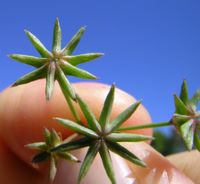 in transection. in transection. |
| Seed | |
| Size range | 8–15 mm long |
| Shape(s) | globoseglobose: 3D shape—more or less spherical  , ellipsoidellipsoid: , ellipsoidellipsoid:3D shape—elliptic , ovoidovoid: 3D shape—ovate  , pear-shaped, oblongoblong: , pear-shaped, oblongoblong:2D shape—much longer than broad with nearly parallel sides, corners are rounded  , polygonalpolygonal: , polygonalpolygonal:angular , tri angularangular: 2D shape—having sides that meet at acute or obtuse angles |
| Surface relief | smooth, striatestriate: surface relief—having fine, parallel lines, grooves or ridges  , ridgedridged: , ridgedridged:surface relief—raised, thick ridges, sharp edged or rounded, usually in a series that may cover the entire surface  , furrowed (spiral, transversetransverse: , furrowed (spiral, transversetransverse:lying, situated, or placed across , obliqueoblique: in a slanting direction or position, neither horizontal nor vertical ), wartywarty: surface relief—distinct, rounded projections that are large relative to the fruit size; tuberculate, verrucose  , wrinkledwrinkled: , wrinkledwrinkled:surface relief—shallow, irregular folds and furrows covering the surface; appearing overall though crumpled and then spread out  , with echinate or pustulatepustular: , with echinate or pustulatepustular:surface relief—with small blisters or pustules 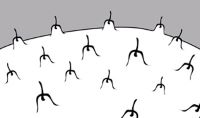 projections projections |
| Color(s) | black, purple, brown, yellow, red, mottledmottled: with colored spots, streaks, or blotches of a different color 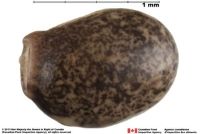 |
| Unique features | Dark seeds often with a basalbasal: at or pertaining to the point of attachment; (of embryo) embryo occupies one end of the seed arilaril: (broad sense) appendicular structure that wholly or partly envelops a seed and is produced from or a modification of the funicle, raphe, or outer integument; usually fleshy or pulpy, sometimes spongy or tufted-capillate, often brightly colored  or fleshy outer seed coat, both of which aid in explosively ejecting seed from fruits. Seeds with fleshy outer seed coat with large, green embryo and ruminateruminate: or fleshy outer seed coat, both of which aid in explosively ejecting seed from fruits. Seeds with fleshy outer seed coat with large, green embryo and ruminateruminate:testa or seed coat folded into the endosperm  endosperm. endosperm. |
| Other | |
| Embryo | well developed, partially to nearly filling seed cavity, axileaxile: on or of the axis and centric, foliatefoliate: appearing leaf-like , straight, with spatulatespatulate: 2D shape—like a spatula; rounded at the apex, with base long and tapered; (of embryo) embryo is straight and axile and centric with the cotyledons expanded to form the shape of a spatula or spoon; (of cotyledons) cotyledons expanded and wider than the stalk but not invested into the stalk  cotyledons cotyledons |
| Nutritive tissue | endosperm copious, fleshy, smooth or ruminateruminate: testa or seed coat folded into the endosperm  (Oxalis) (Oxalis) |
Tropical and subtropical regions, with few temperate species
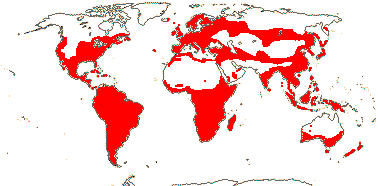
Distribution map courtesy of Angiosperm Phylogeny Website.
Eiten 1963Eiten 1963:
Eiten G. 1963. Taxonomy and Regional Variation of Oxalis Section Corniculatae. I. Introduction, Keys and Synopsis of the Species. The American Midland Naturalist 69(2): 257–309. https://doi.org/10.2307/2422912; Eman et al. 2021Eman et al. 2021:
Eman MS, Amal AD, Hasnaa AH, and Hussein SR. 2021. Taxonomic revision of genus Oxalis L. (Oxalidaceae) in the flora of Egypt. Taeckholmia 41: 56–69.; Farooqui et al. 1985Farooqui et al. 1985:
Farooqui S, Rama Swamy N, and Bahadur B. 1985. Seed morphology in five species of Biophytum DC (Oxalidaceae). Proceedings of Indian Academy of Sciences 95(1): 17–19.; Flora of North America Editorial Committee 1993+Flora of North America Editorial Committee 1993+:
Flora of North America Editorial Committee, eds. 1993+. Flora of North America North of Mexico [Online]. 22+ vols. Flora of North America Association, New York and Oxford. Accessed January-March 2024. URL: http://beta.floranorthamerica.org.; Gerardo Aymard and Berryberry:
an indehiscent, fleshy fruit with one or a few to many seeds. The flesh may be homogenous throughout. Or, if the outer part is hard, firm, or leathery, referred to as an hesperidium. Septa are present in some, and the seeds may be arillate or with a fleshy testa. 2003; Kirkbride et al. 2006Kirkbride et al. 2006:
2003; Kirkbride et al. 2006Kirkbride et al. 2006:
Kirkbride JH, Jr, Gunn CR, and Dallwitz MJ. 2006. Family guide for fruits and seeds, vers. 1.0. Accessed September 2020-January 2022. URL: https://nt.ars-grin.gov/seedsfruits/keys/frsdfam/index.cfm .; Kubitzki et al. 1990+Kubitzki et al. 1990+:
Kubitzki K et al., eds. 1990+. The families and genera of vascular plants. 7+ vols. Berlin etc.; López et al. 2013López et al. 2013:
López A, Panseri AF, and Urtubey E. 2013. Revision of Oxalis section Palmatifoliae DC. (Oxalidaceae). Phytotaxa 138: 1-14. http://dx.doi.org/10.11646/phytotaxa.138.1.1; Lourteig 1975Lourteig 1975:
Lourteig A. 1975. Oxalidaceae extra-Austroamericanae: 1. Oxalis L. sectio Thamnoxys Planchon. Phytologia 29: 449–471.; Lourteig 1979Lourteig 1979:
Lourteig A. 1979. Oxalidaceae extra-Austroamericanae: 2. Oxalis L. sectio Corniculatae DC. Phytologia 42: 57–198.; Noxious Weed Regulations 2020Noxious Weed Regulations 2020:
Noxious Weed Regulations. 2020. 7 C.F.R. sect; 360.100-360.600.; Nuernberg-Silva and Fiaschi 2021Nuernberg-Silva and Fiaschi 2021:
Nuernberg-Silva A and Fiaschi P. 2021. Taxonomic revision and morphology delimitation of Oxalis sect. Ripariae (Oxalidaceae). Phytotaxa 529: 125–159.; Rosenfeldt and Galati 2014Rosenfeldt and Galati 2014:
Rosenfeldt S and Galati BG. 2014. Morphology of the seed coat of Oxalis spp. from Buenos Aires Province (Argentina). Turkish Journal of Botany 38: 864–876.; Takhtajan 2009Takhtajan 2009:
Takhtajan A. 2009. Flowering plants: Second edition. Springer Nature, Switzerland. 871 pp.; Veldkamp 1967Veldkamp 1967:
Veldkamp JF. 1967. A revision of Sarcotheca Bl. and Dapania Korth. (Oxalidaceae). Blumea: Biodiversity, Evolution and Biogeography of Plants 15(2): 519–543.; Veldkamp 1994Veldkamp 1994:
Veldkamp JF. 1994. A new variety of Sarcotheca Laxa (Oxalidaceae) from Sumatra. Blumea: Biodiversity, Evolution and Biogeography of Plants 38(2): 459–460.; Wendt 1987Wendt 1987:
Wendt T. 1987. Plantae Uxpanapae III. A New Species of Biophytum (Oxalidaceae) and five genera new for the Mexican Flora. Brittonia 39: 133–138. https://doi.org/10.2307/2806986; Zhengyi et al. 2004+Zhengyi et al. 2004+:
Zhengyi W, Raven PH, and Deyuan H. 2004+. Flora of China [online]. 25 vols. Science Press, Beijing China & Missouri Botanical Garden, St. Louis USA. Accessed January–March 2024. http://flora.huh.harvard.edu/china/
*The number of genera and species is based on Christenhusz and Byng 2016Christenhusz and Byng 2016:
Christenhusz MJM and Byng JW. 2016. The number of known plant species in the world and its annual increase. Phytotaxa 261 (3): 201-217. https://doi.org/10.11646/phytotaxa.261.3.1, which may differ from the number of genera in GRIN-Global.